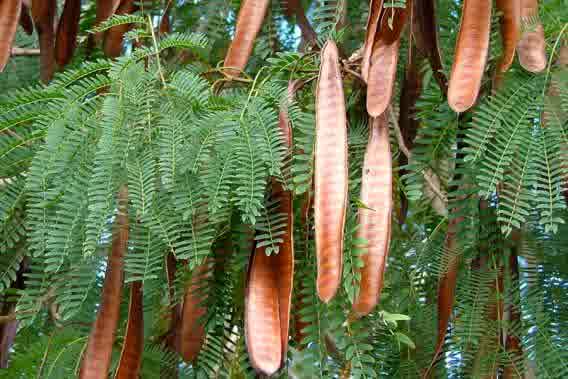Leucaena fodder tree

The various species of leucaena are perennial, deep-rooted, large shrub/small tree legumes growing up to 20 m tall. They have compound leaves with many thin leaflets, white flowers and produce a lot of seeds in pods.
Leucaena has many uses, the leaves are a very good source of protein and can be used in both cut-and-carry and open grazing production systems. Re-growth occurs very fast after cutting.
It can be used as shade in plantation crops, as living supports for climbing crops, such as passion fruit, and also for soil conservation and, being a legume, aids maintenance of soil fertility. Te mature shrub can be cut for poles for fencing and wood fuel and as bee forage.
Advantages
Drought tolerant, highly digestible and palatable forage supplement.
Disadvantages
High mimosine content which can be poisonous in large amounts; can become a weed due to its prolifc seed production
Cultivation
| Climate | Leucaena grows from sea level up to 1900 m but performs best up to 1000 m above sea level. It does well in areas with rainfall above 600 mm per year |
| Soils | It grows best on deep, well drained clay soils and does not do well in acid soils. |
| Site | Leucaena may be planted as single plants, single hedgerows or multiple hedgerows, in cut-and-carry plots, grazed plots, along boundaries or even along contours for soil erosion control. |
| Preparation | Torough seedbed preparation is required. Plough and harrow to make a fne seedbed. |
| Sowing |
Leucaena is established from seeds which can be sown either directly into the feld or in a nursery. To break seed dormancy, soak in warm water for 48 hours, or in boiling water for 4 seconds, or nip the broad (round) end. Inoculate the seed with the correct rhizobia. Make a sticking agent by mixing 2 parts sugar with 1 part of warm water. Mix the sticker thoroughly with required amount of inoculant, following the instructions on the pack. Pour the seeds into the mixture and mix until every seed has a fne sticky coating. Spread the seed to dry in cool shade for 15 to 30 minutes. Plant immediately. For direct sowing in the fnal growing site, make furrows 3 to 10 m apart and sow the seed at a rate of 1 to 2 kg per hectare, planting the seeds 2 to 3 cm deep. For nursery propagation, use plastic tubes flled with free-draining soil, sand and manure in the ratio of 3:2:1. Sow two seeds per tube. Water regularly as required and control weeds by hand pulling. One week after the seedlings emerge, thin to one seedling per tube. Transplant seedlings when they are eight weeks old. For a pure stand, prepare holes spaced 1 m by 1 m and at least 30 cm deep. For alley cropping or grazing, allow a spacing of 75 cm between plants and 3 to 10 metres between rows. Remove plastic tubes and place the seedling in the holes. Cover with moist soil and frm around the seedling. |
| Fertilizer | At the time of transplanting, apply triple super phosphate fertilizer at the rate of 120 kg per hectare, or one tablespoon per hole, and mix with soil. |
| Weeding | Leucaena seedlings are very susceptible to weed competition, therefore make sure the plot is weed-free when the seedlings are small. |
| Pests |
The psyllid insect (Heteropsylla cubenseis) is the most important pest and it can wipe out the entire crop, especially of the species L. leucocephala. To control it, plant species that are resistant to this pest such as L. diversifolia. Biological control using a beetle and a parasitic wasp is showing promise. Damping-off is an important fungal disease affecting seedlings in the nursery. This is controlled by avoiding excess watering and using free-draining soil. |
| Harvesting |
Start harvesting at the beginning of the second wet season by cutting back to 50 cm above ground level. Cut twice during the wet season when re-growth is 50-60 cm, or once at the end and conserve as dry leaf meal. First grazing may be done when the plants are 1.5 m in height but it should be light at frst. Avoid heavy grazing until the plants are fully mature, from 1 to 3 years old. Grazing or harvesting When well managed, leucaena can yield up to 2 tonnes dry matter per hectare per year. |
| Feeding | Leucaena is a high quality, very palatable supplementary forage. It is best cut and fed fresh or as dry leaf meal. Feeding excessive amounts can cause bloat and hair loss, therefore leucaena should not make up more than 30% of the total ration. Leucaena leaves can be dried and fed as dry leaf meal |



Comments
RSS feed for comments to this post